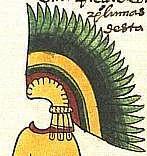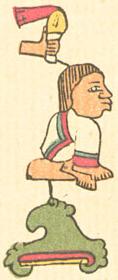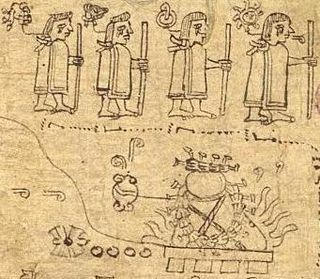Related Research Articles
Domingo Francisco de San Antón Muñón Chimalpahin Quauhtlehuanitzin, usually referred to simply as Chimalpahin or Chimalpain, was a Nahua annalist from Chalco. His Nahuatl names mean "Runs Swiftly with a Shield" and "Rising Eagle", respectively, and he claimed descent from the lords of Tenango-Amecameca-Chalco. He was the grandson of the late Don Domingo Hernández Ayopochtzin, a seventh-generation descendant of the founding king of the polity. Don Domingo was learned and esteemed, especially for his education and his record-keeping skills in the ancient tradition.

Acacitli was a Mexica chief and one of the "founding fathers" of Tenochtitlan, the capital of the Aztec Empire.
Aculnahuacatl Tzaqualcatl was the first tlatoani (ruler) of the pre-Columbian Tepanec altepetl of Tlacopan in the Valley of Mexico.
Huehue Zaca or Çaca, also Zacatzin, was a 15th-century Aztec noble, prince and a warrior who served as tlacateccatl under the ruler Moctezuma I, his brother. The name of Zaca is probably derived from Nahuatl zacatl, meaning "grass"; -tzin is an honorific or reverential suffix. Huehue is Nahuatl for "the elder", literally "old man".
Don Juan de Guzmán Itztolinqui was a post-Conquest tlatoani (ruler) of the altepetl of Coyoacán in the Valley of Mexico.

Tlilpotonqui or Tlilpotoncatzin was the second cihuacoatl ("president") of Mexico-Tenochtitlan.

Xilomantzin was the tlatoani ("king") of the pre-Columbian altepetl of Culhuacan in the Valley of Mexico from 1440 to 1473.
Tezcatlan Miyahuatzin was the second Queen of Tenochtitlan.

Atotoztli I was a Princess of Culhuacan.
Coxcoxtli was a king of city-state Culhuacán.
Huitzilxotzin was a Queen of Tenochtitlan as a wife of Aztec emperor Acamapichtli. She was a daughter of Tenqacatetl and mother of Prince Tlatolqaca. She was a grandmother of Princes Cahualtzin, Tetlepanquetzatzin and Tecatlapohuatzin.
Xiuhcuetzin was a Queen of Tenochtitlan as a wife of Aztec emperor Acamapichtli. She was a daughter of Ahatl and mother of Prince Quatlecoatl.
Matlalxoch was an Aztec princess, the only daughter of Emperor Acamapichtli. She was a half-sister of Emperors Huitzilihuitl and Itzcoatl and half-aunt of Emperors Chimalpopoca and Moctezuma I. She is mentioned by Chimalpahin.
Quatlecoatl was an Aztec prince, son of Emperor Acamapichtli and Queen Xiuhcuetzin, half-brother of Emperors Huitzilihuitl and Itzcoatl, an uncle of Chimalpopoca and Moctezuma I.
Miyahuaxochtzin of Tiliuhcan was a Queen of Tenochtitlan as a wife of King Huitzilihuitl. She was a daughter of King Tlacacuitlahuatzin and sister of Princess Matlalxochtzin and Queen Tlacochcuetzin. She was the mother of Prince Huehue Zaca and aunt of Princes Cahualtzin, Tetlepanquetzatzin, Tecatlapohuatzin, Coauoxtli and Oquetzal. She was also a grandmother of the King Huitzilatzin.
Maquiztzin was the daughter of the Aztec Tlatoque (ruler) Huehue Quetzalmacatzin and Tlacocihuatzin Ilama, in 15th-century Mesoamerica.
Cacamacihuatl was a Queen of Tenochtitlan as a wife of the King Huitzilihuitl. She was a mother of Prince Tlacaelel I and grandmother of Cacamatzin and Tlilpotoncatzin.

Tzihuacxochitzin I was a Queen consort of Azcapotzalco as a wife of the king Tezozomoc, who was very famous.
Huehue Quetzalmacatzin was a tlatoani (ruler) of Amaquemecan in 15th-century Mesoamerica.
References
- ↑ Cote : Mexicain 74
- ↑ Battcock, Clementina (2019), "Chimalpahin, su formación y sus noticias sobre la presencia de la Iglesia Católica en Chalco Amaquemecan, siglos XVI-XVII", Revista de Historia de América (in Spanish) (157): 71–85, doi:10.35424/rha.157.2019.35
- ↑ Cortés, Rocío, Don Domingo de San Francisco Antón Muñón Chimalpahin Cuauhtlehuanitzin (doc)
- ↑ Chimalpahin Cuauhtlehuanitzin, Domingo Francisco de San Antón Muñón, 1579-1660. (1997). Codex Chimalpahin : society and politics in Mexico Tenochtitlan, Tlatelolco, Texcoco, Culhuacan, and other Nahua altepetl in central Mexico : the Nahuatl and Spanish annals and accounts collected and recorded by don Domingo de San Antón Muñón Chimalpahin Quauhtlehuanitzin. Anderson, Arthur J. O., Schroeder, Susan., Ruwet, Wayne. Norman, Okla.: University of Oklahoma Press. ISBN 0806129212. OCLC 36017075.
{{cite book}}: CS1 maint: multiple names: authors list (link) - ↑ de San Antón Muñón Chimalpain Cuauhtlehuanitzin, Domingo Francisco, "Memorial breve acerca de la fundación de la ciudad de Culhuacan" (PDF), Segunda Relación